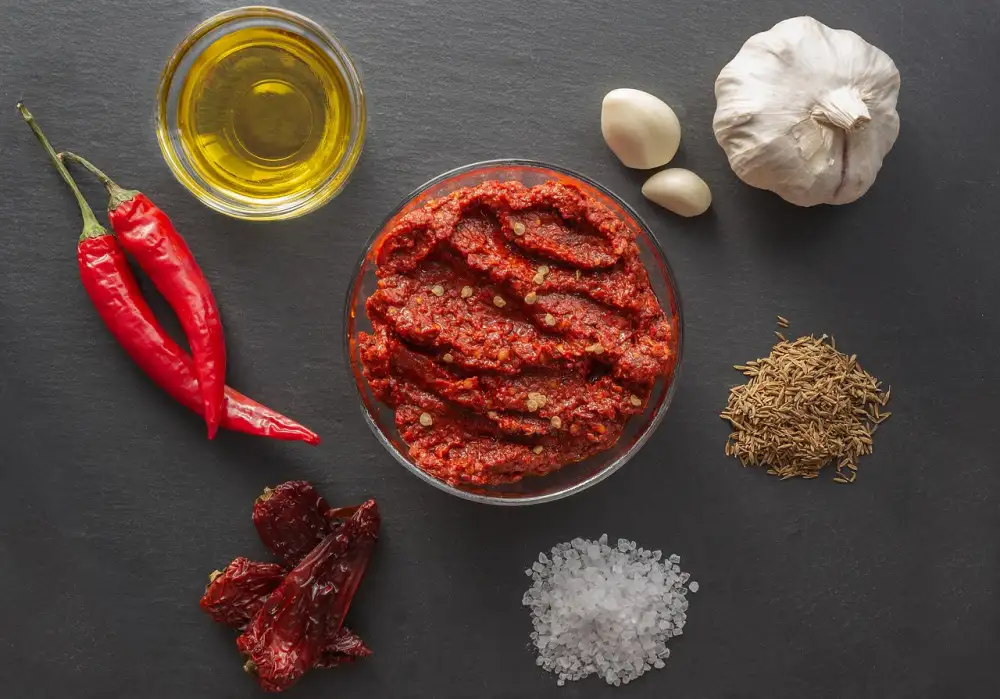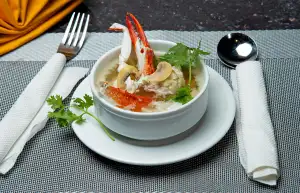Spice up Your Culinary Adventures with Harissa Paste: Exploring the Fiery Flavors of North African Cuisine

- Origins and Cultural Significance of Harissa Paste
- Traditional Ingredients Used in Harissa Paste
- The Spicy Flavor Profile of Harissa Paste
- Health Benefits of Harissa Paste
- Modern Adaptations and Variations of Harissa Paste
- How to Make Harissa Paste at Home
- Creative Ways to Use Harissa Paste in Recipes
- Tips for Storing and Preserving Harissa Paste
Harissa paste is a fiery and flavorful condiment that originates from North African cuisine. It is known for its vibrant red color and intense spiciness, making it a must-have ingredient for those who love bold flavors. This versatile paste can be used to add depth and heat to a variety of dishes, from stews and soups to marinades and dips. Whether you're a spice enthusiast or simply looking to experiment with new flavors, harissa paste is sure to elevate your culinary adventures to new heights.
Origins and Cultural Significance of Harissa Paste
Harissa paste is a fiery condiment that hails from North Africa, specifically Tunisia. It holds immense cultural significance in the region and is considered a staple in Tunisian cuisine. The origins of harissa paste can be traced back to the Berber people, who have been using it for centuries to add heat and flavor to their dishes. In fact, harissa paste is so deeply ingrained in Tunisian culture that it is often referred to as "the soul of the cuisine." It is not just a condiment; it represents the rich history and vibrant flavors of North African cooking.
Traditional Ingredients Used in Harissa Paste
Harissa paste is a fiery and flavorful condiment that originates from North Africa, specifically Tunisia. This versatile paste is made using a combination of traditional ingredients that give it its distinct taste and aroma.
The key ingredient in harissa paste is dried red chili peppers, which are responsible for its intense heat. These chilies are typically deseeded and soaked in water before being ground into a paste. Other spices such as cumin, coriander, and caraway seeds are also commonly used to enhance the flavor profile of the paste.
Garlic cloves add a pungent and aromatic element to the paste, while olive oil helps to bind all the ingredients together and gives it a smooth consistency. Some variations of harissa may also include tomatoes or tomato paste for added depth of flavor.
To balance out the heat, sweetness is often incorporated into harissa paste through the use of roasted red bell peppers or sun-dried tomatoes. These ingredients not only add a hint of sweetness but also contribute to the vibrant red color of the paste.
Traditionally, harissa paste is seasoned with salt and preserved with lemon juice or vinegar, which not only adds tanginess but also helps to extend its shelf life. However, these preservation methods can vary depending on regional preferences.
The combination of these traditional ingredients creates a complex and bold flavor profile that is both spicy and savory. The unique blend of spices gives harissa paste its distinctive North African taste, making it an essential ingredient in many dishes from this region.
Whether used as a marinade for grilled meats, stirred into stews or soups, or spread onto sandwiches or roasted vegetables, harissa paste adds an explosion of flavors that will elevate any dish to new heights.
The Spicy Flavor Profile of Harissa Paste
The fiery flavor profile of harissa paste is what sets it apart from other condiments. It is known for its intense heat and smoky undertones, making it a must-have for spice lovers. The combination of chili peppers, garlic, and spices creates a complex and robust taste that adds depth and excitement to any dish. Whether used as a marinade, a dip, or a seasoning, harissa paste brings a bold and unforgettable kick to your culinary creations.
Health Benefits of Harissa Paste
Harissa paste not only adds a fiery kick to your dishes but also brings along several health benefits. Packed with capsaicin, the compound responsible for its spiciness, harissa paste can boost metabolism and aid in weight loss. Additionally, capsaicin has been shown to have anti-inflammatory properties and may help reduce pain. The paste is also rich in vitamins A and C, which are essential for a healthy immune system. Furthermore, the garlic and olive oil used in harissa paste provide antioxidants that promote heart health. So, by incorporating harissa paste into your meals, you can spice up your culinary adventures while reaping these nutritional benefits.
Modern Adaptations and Variations of Harissa Paste
As the popularity of harissa paste continues to grow, chefs and home cooks are experimenting with new adaptations and variations of this fiery condiment. Some modern versions include the addition of ingredients like roasted red peppers, sun-dried tomatoes, or even smoked paprika for an extra depth of flavor. Others may opt for a milder version by reducing the amount of chili peppers used or adding a touch of sweetness with honey or maple syrup. These adaptations allow for a personalized touch and make harissa paste more versatile in various cuisines. Whether you prefer it smoky, sweet, or extra spicy, there's a harissa paste variation out there to suit every palate.
How to Make Harissa Paste at Home
To make harissa paste at home, you will need the following ingredients: dried chili peppers (such as Aleppo or Guajillo), garlic cloves, cumin seeds, coriander seeds, caraway seeds, tomato paste, olive oil, lemon juice, salt, and a pinch of sugar.
Start by soaking the dried chili peppers in hot water for about 30 minutes until they become soft. Drain the water and remove the stems and seeds from the peppers.
In a dry skillet over medium heat, toast the cumin seeds, coriander seeds, and caraway seeds until fragrant. Let them cool slightly before grinding them into a fine powder using a mortar and pestle or a spice grinder.
Next, combine the soaked chili peppers, garlic cloves, ground spices, tomato paste, olive oil, lemon juice, salt, and sugar in a food processor or blender. Blend until you achieve a smooth paste-like consistency.
Taste the harissa paste and adjust the seasoning according to your preference. If you prefer it spicier, you can add more chili peppers or even include some of their seeds.
Transfer the harissa paste into an airtight container and store it in the refrigerator for up to two weeks. The flavors will continue to develop over time.
Now that you know how to make harissa paste at home, get ready to add a fiery kick to your culinary creations!
Creative Ways to Use Harissa Paste in Recipes
1. Marinades: Add a spoonful of harissa paste to your marinades for meats, seafood, or vegetables. The spicy flavors will infuse into the ingredients, giving them a delicious kick.
2. Salad Dressings: Mix harissa paste with olive oil, lemon juice, and herbs to create a zesty dressing for salads. It adds depth and heat to your greens.
3. Sandwich Spreads: Spread harissa paste on bread or wraps as a condiment for sandwiches. It pairs well with grilled chicken, roasted vegetables, or even cheese.
4. Roasted Vegetables: Toss your favorite vegetables with harissa paste before roasting them in the oven. The paste caramelizes and enhances the natural sweetness of the veggies.
5. Pasta Sauce: Stir harissa paste into tomato-based pasta sauces for an extra layer of flavor and heat. It works especially well with spicy sausage or shrimp dishes.
6. Dips and Spreads: Blend harissa paste with creamy ingredients like Greek yogurt or hummus to create flavorful dips and spreads for crackers or vegetable sticks.
7. Grilled Meats: Brush harissa paste onto grilled meats like chicken, lamb, or beef during cooking for a fiery glaze that adds complexity to the dish.
8. Rice and Grain Bowls: Mix harissa paste into cooked rice or grains like quinoa or couscous for a vibrant and spicy side dish that complements any protein.
9. Eggs: Add a dollop of harissa paste to scrambled eggs or omelets for a burst of flavor in your breakfast routine.
10. Pizza Topping: Spread a thin layer of harissa paste on pizza dough before adding toppings for an unconventional twist on traditional pizza flavors.
With these creative uses, you can explore the versatility of harissa paste and elevate your culinary creations with its fiery flavors!
Tips for Storing and Preserving Harissa Paste
1. Store in airtight containers: To maintain the freshness and flavor of your homemade harissa paste, transfer it to clean, airtight jars or containers. This will help prevent oxidation and extend its shelf life.
2. Refrigerate for longer storage: While harissa paste can be stored at room temperature for a short period, it is best to refrigerate it for longer shelf life. The cold temperature will slow down bacterial growth and keep the paste fresh for up to several weeks.
3. Use oil as a preservative: Cover the surface of the harissa paste with a thin layer of olive oil before sealing the container. This creates a barrier that helps preserve the paste by preventing air from reaching it.
4. Label and date your containers: To avoid confusion, label each container with the date you made the harissa paste. This will help you keep track of its freshness and ensure you use it within a reasonable time frame.
5. Freeze for extended storage: If you have made a large batch of harissa paste or want to store it for an extended period, consider freezing it in small portions. Place the paste in freezer-safe containers or ice cube trays, then transfer them to freezer bags once frozen solid. Frozen harissa can last for several months.
By following these tips, you can ensure that your homemade harissa paste remains flavorful and ready to enhance your culinary creations whenever needed.
In conclusion, embracing the spicy and versatile Harissa paste is a surefire way to elevate your culinary adventures. Whether you're a fan of North African cuisine or simply looking to add some heat to your dishes, Harissa paste is a must-have ingredient in your pantry. Its rich history, traditional ingredients, and fiery flavor profile make it a unique and exciting addition to any recipe. From marinades and dressings to dips and spreads, there are countless creative ways to incorporate Harissa paste into your cooking. So why not spice up your life and explore the vibrant flavors of North African cuisine with this fiery condiment?
Published: 17. 11. 2023
Category: Food



